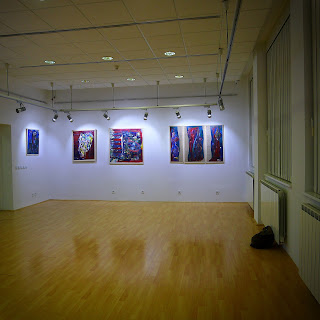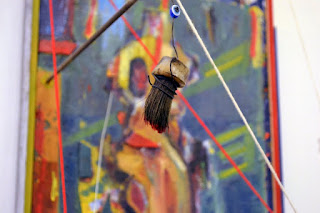FRICTION
Belgrade City Library – Gallery Atrium
Friction
A
Judeo-Christian view of the West is characterized by the belief that history
has an objective or at least a direction. Conversely, the understanding of history
in non-Western cultures and inPre-Socraticopinion was determined by the
cyclical idea of eternal return.
Then, the Enlightenment changed the idea of the time flow…..
Georg G.Iggers:
Historiography in the Twentieth
Century.
Friction
is a multimedia exhibition resulting from the
experimental film Friction(premiered at the 65th edition of
The March Festival – Belgrade Documentary and Short Film Festival, 2018).
The idea of this exhibition is to transgress the
line between certain media, where the content would flow from one medium into
another, while constantly emphasizing the threshold between them.
It is a postmodern process which draws the basic
content into several directions, diversifying it, where each branch still
belongs to the source, but is at the same time a new conceptual and thought
form with its own narrative and its own artistic identity. By examining the
narrative as well as the abstractness of the form, this exhibition accentuates
the multitude of interpretation of the works themselves and the diversity of
experience in the observer.
A symbolic intent permeates throughout the film
- different circular forms which suggest the continuity of the time flow
through cyclical processes. Through works in the artistic form, the time flow
itself is reduced to abstract images, which have no beginning or end (as
features defining the abstraction), however,micro manifestations may be
perceived in them, which, by their presence, deconstruct the entire idea of Absolute-abstraction,
placing the movie and artistic manifestations emerging from it in an ambivalent
and interactive relationship. By building a boundary zone, open to all types of interpretation and reading, the boundary zone of indeterminacy,
this exhibition emphasizes that the only valid gravity point is our own
individual experience, the viewpoint which participates in the transmutation of
consciousness and helps us to see reality in a completely new and extraordinary
way.
Such a view allows for a wide array of
expressive means and experimental complexity by examining the stylistic
crossing of abstract and figural (real) elements and not relating to one
expressive style only. By establishing the framework of the inner system, this exhibition seeks to develop the language capable of causing
various paths of penetration into an inert everyday life, thus creating a language
system through which the effects of deconstruction, nominalism, recycling,
permeation and eclecticism pervade.
The film Friction, through
various formal manifestations and their simultaneous perception, refers to the
very process of perception and re-examination (of the perception process)
through different thinking systems.




























































